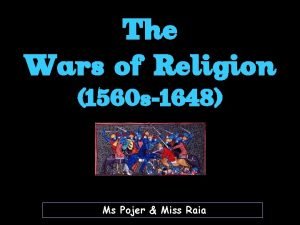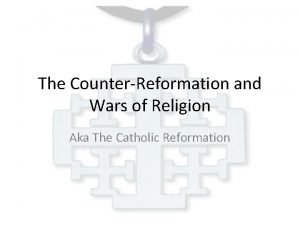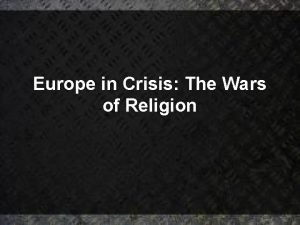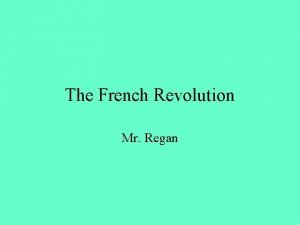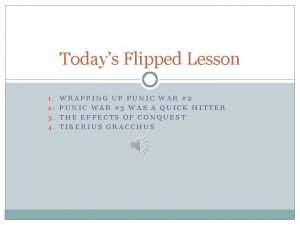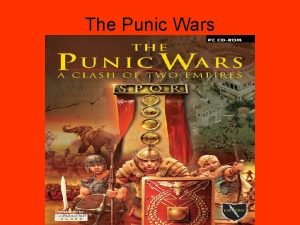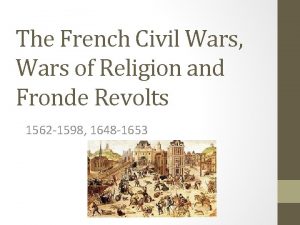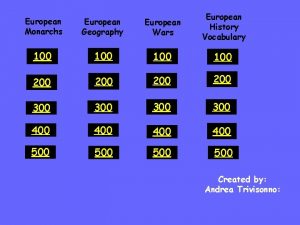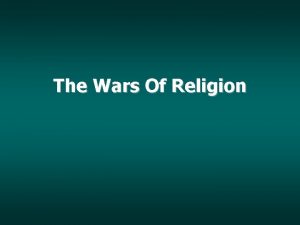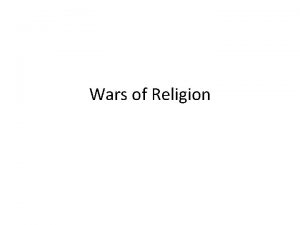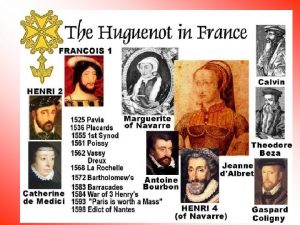European Wars of Religion FRENCH WARS OF RELIGION










- Slides: 10

European Wars of Religion FRENCH WARS OF RELIGION AND THE THIRTY YEARS WAR

Objectives �We will be able to identify the causes and consequences of religious conflict in Europe in the 16 th and 17 th centuries.

16 th Century French Wars of Religion �Protestant Huguenots rebelled against Catholic domination in 1572. �This set off a civil war in France that would last until the turn of the century.

Early 16 th Century France � France was divided by law, customs, languages and traditions. However, the majority of France was Catholic � Nobles were resisting the expansion of King Francis I power. � These divisions, along with the Protestant Reformation reaching France in the mid 1500 s, would ultimately lead to civil war.

Protestantism in France � Followers of John Calvin arrived in France in the 1550 s and 1560 s. � They attracted many converts. � Henry II, a catholic, began a religious repression that created many martyrs, further encouraging Protestant dissent. � Authoritarian French rulers faced Protestant noble challenges, which further increased tensions.

The Wars…… � For thirty years, fighting broke out between Catholics and Protestant Huguenots. � The St. Bartholomew’s Day Massacre is a microcosm of the wars themselves. Text Pg. 448. De Thou – Primary Source Analysis � Total Casualties…. 2 mil – 4 mil

The Edict of Nantes � In 1589, King Henry IV, issues the Edict of Nantes. � The edict granted official toleration of Huguenots, along with two hundred towns with troops. � Henry IV also brought Huguenots into his administration. � Henry believed that the king was all powerful and should be obeyed regardless of his religion.

The Thirty Years War � The most devastating conflict of the seventeenth century. Total Casualties 3 mil – 11. 5 mil � War had religious and dynastic elements. Catholic militants fighting protestant militants throughout central Europe. Certain families allied with each other as well. � The war began in Bohemia, with the Defenestration of Prague (126), and spread throughout the Holy Roman Empire. � Every major power in Europe was involved as some point. Bohemian phase, Danish phase, Swedish phase, and French phase.

The Nature of the War �The war was incredibly brutal. The population of the Holy Roman Empire fell by 15 to 20 percent. Certain areas, like Bohemia and the Baltic coast, saw population fall by 50 percent. �A first hand account of the destruction of Magdeburg.

Peace of Westphalia �In 1648, the war came to an end. �The most lasting aspect of the Peace of Westphalia was it allowed states within the Holy Roman Empire to choose their own state religion. http: //www. youtube. com/ watch? v=c-WO 73 Dh 7 r. Y
